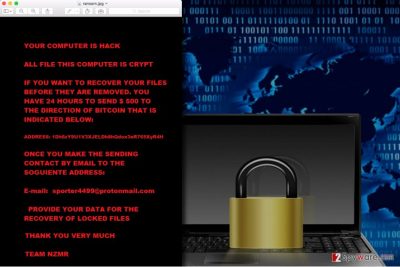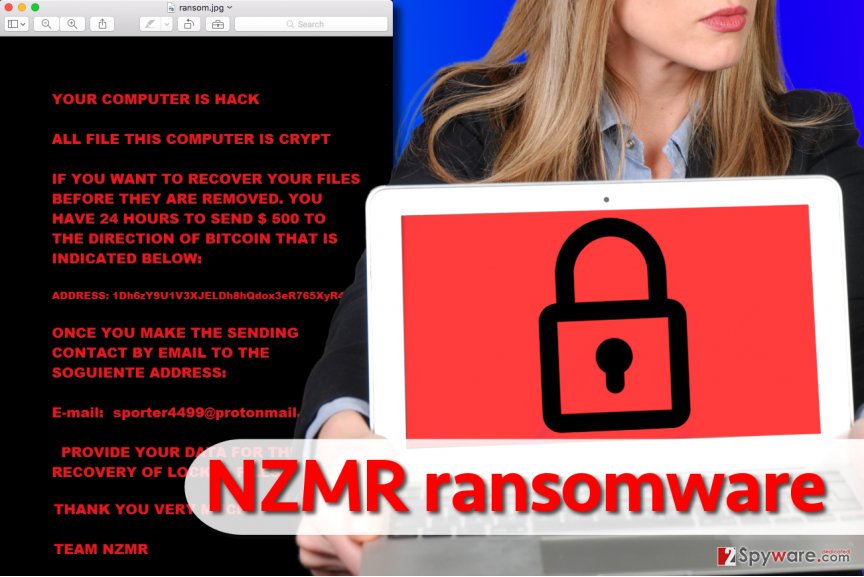NZMR ransomware / virus (Decryption Steps Included) - Virus Removal Instructions
NZMR virus Removal Guide
What is NZMR ransomware virus?
NZMR ransomware asks for half a thousand US dollars as a ransom

NZMR ransomware is a malicious computer virus[1] that encrypts files and demands $500 as a ransom. The ransomware is based on open-source viruses EDA2 and HiddenTear. After encrypting all files, the virus provides the message from the victims by dropping the ransom.jpg file. This file contains a message that says:
All file this computer is crypt
If you want to recover your files before they are removed. You have 24 hours to send $ 500 to the direction of Bitcoin that is indicated below:
Address: [redacted]
Once you make the sending contact by email to the soguiente address:
Email: sporter4499@protonmail.comProvide your data for the recovery of locked files
Thank you very much
Team NZMR
As you can see, the ransom note suggests writing to sporter4499@protonmail.com to get the decryptor. However, currently, it is unknown whether cybercriminals provide the decryption tools or not. At the moment of writing this article, the Bitcoin wallet[2] associated with NZMR ransomware hasn’t received any Bitcoins and was completely empty.
When files get encrypted by ransomware, the victim has to decide whether to pay the ransom or not. We tend to suggest not to pay the ransom because of the risk of losing money along with files. Sadly, files encrypted by this ransomware cannot be recovered using any third-party tools (at least at the moment of writing), but you can always use a data backup.
Before restoring your files, you have to remove NZMR virus. To complete this task, we strongly recommend using an anti-spyware tool like FortectIntego. If you’d like to see more alternatives, check out the “Software” page on our site.

Distribution of the virus
NZMR ransomware is distributed in a traditional and the most popular way of malware distribution. Cyber criminals create malicious files that function as intermediates that download the ransomware to the computer. It can be a document that contains a malicious Macro function, JavaScript or another compromised file.
Obviously, to protect yourself from such files, you should never open suspicious email attachments or URLs sent to you by strangers. However, ransomware can be installed on your computer by exploiting software vulnerabilities in your PC. To patch these vulnerabilities, continuously update programs.
Finally, to protect your files from a fearsome encryption procedure, create a backup and employ a powerful anti-malware software to protect your PC. We also recommend you to follow the news on Virus Activity site[3] to know more about the latest malware and spyware samples.
Deleting NZMR ransomware virus
Remove NZMR virus as soon as you can because only then you will get a chance to use your computer without worries again. Please understand that ransomware is no regular program and it cannot be uninstalled traditionally. Each ransomware is different and contains various files, so using anti-malware software would be the best idea.
Another reason why we recommend using anti-malware programs is that they are developed by security experts that analyze each virus individually and put up the latest information about them to security programs.
This makes those security products capable of detecting the latest security threats. Please, do not even consider the manual NZMR removal option unless you are extremely experienced IT professional.
Getting rid of NZMR virus. Follow these steps
Manual removal using Safe Mode
To remove NZMR malware from your Windows computer, you need to restart your PC and run it into a mode suitable for malware removal. Here's what you need to do.
Important! →
Manual removal guide might be too complicated for regular computer users. It requires advanced IT knowledge to be performed correctly (if vital system files are removed or damaged, it might result in full Windows compromise), and it also might take hours to complete. Therefore, we highly advise using the automatic method provided above instead.
Step 1. Access Safe Mode with Networking
Manual malware removal should be best performed in the Safe Mode environment.
Windows 7 / Vista / XP
- Click Start > Shutdown > Restart > OK.
- When your computer becomes active, start pressing F8 button (if that does not work, try F2, F12, Del, etc. – it all depends on your motherboard model) multiple times until you see the Advanced Boot Options window.
- Select Safe Mode with Networking from the list.

Windows 10 / Windows 8
- Right-click on Start button and select Settings.

- Scroll down to pick Update & Security.

- On the left side of the window, pick Recovery.
- Now scroll down to find Advanced Startup section.
- Click Restart now.

- Select Troubleshoot.

- Go to Advanced options.

- Select Startup Settings.

- Press Restart.
- Now press 5 or click 5) Enable Safe Mode with Networking.

Step 2. Shut down suspicious processes
Windows Task Manager is a useful tool that shows all the processes running in the background. If malware is running a process, you need to shut it down:
- Press Ctrl + Shift + Esc on your keyboard to open Windows Task Manager.
- Click on More details.

- Scroll down to Background processes section, and look for anything suspicious.
- Right-click and select Open file location.

- Go back to the process, right-click and pick End Task.

- Delete the contents of the malicious folder.
Step 3. Check program Startup
- Press Ctrl + Shift + Esc on your keyboard to open Windows Task Manager.
- Go to Startup tab.
- Right-click on the suspicious program and pick Disable.

Step 4. Delete virus files
Malware-related files can be found in various places within your computer. Here are instructions that could help you find them:
- Type in Disk Cleanup in Windows search and press Enter.

- Select the drive you want to clean (C: is your main drive by default and is likely to be the one that has malicious files in).
- Scroll through the Files to delete list and select the following:
Temporary Internet Files
Downloads
Recycle Bin
Temporary files - Pick Clean up system files.

- You can also look for other malicious files hidden in the following folders (type these entries in Windows Search and press Enter):
%AppData%
%LocalAppData%
%ProgramData%
%WinDir%
After you are finished, reboot the PC in normal mode.
Remove NZMR using System Restore
-
Step 1: Reboot your computer to Safe Mode with Command Prompt
Windows 7 / Vista / XP- Click Start → Shutdown → Restart → OK.
- When your computer becomes active, start pressing F8 multiple times until you see the Advanced Boot Options window.
-
Select Command Prompt from the list

Windows 10 / Windows 8- Press the Power button at the Windows login screen. Now press and hold Shift, which is on your keyboard, and click Restart..
- Now select Troubleshoot → Advanced options → Startup Settings and finally press Restart.
-
Once your computer becomes active, select Enable Safe Mode with Command Prompt in Startup Settings window.

-
Step 2: Restore your system files and settings
-
Once the Command Prompt window shows up, enter cd restore and click Enter.

-
Now type rstrui.exe and press Enter again..

-
When a new window shows up, click Next and select your restore point that is prior the infiltration of NZMR. After doing that, click Next.


-
Now click Yes to start system restore.

-
Once the Command Prompt window shows up, enter cd restore and click Enter.
Bonus: Recover your data
Guide which is presented above is supposed to help you remove NZMR from your computer. To recover your encrypted files, we recommend using a detailed guide prepared by 2-spyware.com security experts.If your files are encrypted by NZMR, you can use several methods to restore them:
Restore files the Data Recovery Pro way
Data Recovery Pro is an excellent tool that comes in handy when dealing with piles of compromised or erased data. Check out this mini-tutorial that explains how to recover files with a help of this utility.
- Download Data Recovery Pro;
- Follow the steps of Data Recovery Setup and install the program on your computer;
- Launch it and scan your computer for files encrypted by NZMR ransomware;
- Restore them.
ShadowExplorer trick
ShadowExplorer is a software that helps to recover compromised files from their Volume Shadow Copies. Unfortunately, ransomware viruses tend to delete these copies to prevent victims from restoring their files without paying the ransom.
- Download Shadow Explorer (http://shadowexplorer.com/);
- Follow a Shadow Explorer Setup Wizard and install this application on your computer;
- Launch the program and go through the drop down menu on the top left corner to select the disk of your encrypted data. Check what folders are there;
- Right-click on the folder you want to restore and select “Export”. You can also select where you want it to be stored.
Finally, you should always think about the protection of crypto-ransomwares. In order to protect your computer from NZMR and other ransomwares, use a reputable anti-spyware, such as FortectIntego, SpyHunter 5Combo Cleaner or Malwarebytes
How to prevent from getting ransomware
Stream videos without limitations, no matter where you are
There are multiple parties that could find out almost anything about you by checking your online activity. While this is highly unlikely, advertisers and tech companies are constantly tracking you online. The first step to privacy should be a secure browser that focuses on tracker reduction to a minimum.
Even if you employ a secure browser, you will not be able to access websites that are restricted due to local government laws or other reasons. In other words, you may not be able to stream Disney+ or US-based Netflix in some countries. To bypass these restrictions, you can employ a powerful Private Internet Access VPN, which provides dedicated servers for torrenting and streaming, not slowing you down in the process.
Data backups are important – recover your lost files
Ransomware is one of the biggest threats to personal data. Once it is executed on a machine, it launches a sophisticated encryption algorithm that locks all your files, although it does not destroy them. The most common misconception is that anti-malware software can return files to their previous states. This is not true, however, and data remains locked after the malicious payload is deleted.
While regular data backups are the only secure method to recover your files after a ransomware attack, tools such as Data Recovery Pro can also be effective and restore at least some of your lost data.
- ^ Malicious programs. Securelist. Information about Viruses, Hackers and Spam.
- ^ Danny Palmer. http://www.zdnet.com/article/how-bitcoin-helped-fuel-an-explosion-in-ransomware-attacks/. ZDNet. Technology News, Analysis, Comments and Product Reviews.
- ^ The main page of Virus Activity site. Virus Activity. The Latest News about Computer Viruses and Cyber Threats.





















